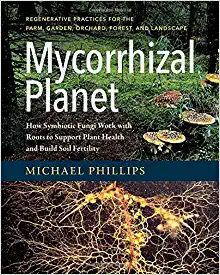By Michael Phillips
The following excerpt is adapted from Micheal Phillips’ Mycorrhizal Planet: How Symbiotic Fungi Work with Roots to Support Plant Health and Build Soil Fertility and is reprinted with the permission of the author.
Healthy plant metabolism begins with a molecule of water, a breath of carbon, and light energy from our nearest star. The tangible science behind all this unlocks the righteous way to farm and garden, give honor to trees, and plain do right by this earth. Nothing has ever excited me more.
A few core concepts set the stage for this exploration into plant health.
The dictionary tells us that health reflects the functional efficiency of a living organism. Primary metabolic processes for plants involve photosynthesis, respiration, and the synthesis of organic compounds needed to sustain life. Being sustained sounds kind of good, like bearing up under stress. Wherein enters the term plant secondary metabolism. These phytochemical pathways aid in the growth and development of plants, but are “not required for the plant to survive.” Hmmm. That parting shot is taught the world over in biology classes (and thus the quotes), yet what a dumb thing to say to a grower or an herbalist.
Reductionist science has gotten us into trouble before. The ensuing biochemistries of vascular metabolism play a pinnacle role in keeping plants healthy. A wide range of constituents are used as defensive mechanisms to ward off herbivores, pests, and pathogens. Some metabolites make leaves taste bitter, and can even prove toxic. Most notably, quite a number of these compounds not only trigger a resistance response, but become the means by which plants thwart fungal and bacterial disease. Plant hormones regulate metabolic activity within cells. Allelopathic interactions inhibit the growth of competitors. Pigments such as carotenes and flavonoids color flowers and, together with phenolic odors, attract pollinators. Another phenolic compound known as lignin adds stiffness and strength to cell walls. This complex polymer provides structural support to trees reaching upward to the sky as well as amber waves of grain rippling in the breeze.
And yet, all such secondary metabolites are viewed as nonessential to the functioning of plants? Sounds like a plot to promote human intervention to me. Serious kidding aside, let’s ponder for a minute what it means to be an unhealthy plant.
A number of things may go awry. Aphids crowd in to suck plant juices. Moth larvae nip and tuck at new growth. Scab, rust, and blight spread mercilessly. Beetles skeletonize leaves till only veins remain. Mineral deficiencies abound. Bacterial canker and eye of newt. Rotting root and cauldron bubble. Something wicked this way comes!
Modern farming systems are regrettably unhealthy by choice. Fungicides, insecticides, and herbicides are no more than medications applied to compensate for practices that harm soil life. The resulting harvest may be “productive,” but the food itself lacks meaningful nourishment by half, and offers even less in the way of antioxidants needed by our bodies to ward off degenerative disease. On the other hand, dealing with countless symptoms spurred on by empty foods has become quite the boon for modern medicine. All comes round when we realize that parallels exist between human health and plant health.
Pests and pathogens encountered by plants should be considered “symptoms” resulting from a breakdown of natural defenses. Just as we humans have an immune system to ward off everyday encounters with germ organisms, plants have phytochemical abilities with which to face similar encounters in the green world. Plant resistance to insect feeding depends upon metabolic processes going the distance . . . along with an assist from beneficial insects. Plant resistance to pathogenic fungi and bacteria depends upon metabolic processes going the distance . . . along with competitive colonization on the part of friendly microorganisms from root tip to shoot tip. The prospects for such complete metabolism, of course, pivot on mineral availability and mycorrhizal collaboration.
Plants with full access to balanced nutrition provide a very different bill of fare for pests and pathogens seeking a niche to exploit. Our foray into a health perspective will assume a wide range of minerals are on hand in reasonable proportion. Later on, we will put on our thinking caps to explore just what proper mineral investment might look like. Mycorrhizal fungi perform an important role in balanced nutrition as well. Select nutrients go to the host plant offering the better carbon trade. Sometimes the deal involves partially built proteins; other times its trace mineral complexes from newly mined rock. The abundance provided every time one organism gives way to another frees up the profoundest offerings of all. This underground economy invokes ecosystem intelligence and an interdependence of species that we’ll be marveling at shortly. Plants in turn take these elements and provide oxygen and sustenance for all who walk in beauty on this good earth.
We’ll proceed under the unified banner of healthy plant metabolism. From here on in let’s think of plant health in the affirmative. Vibrancy. Vitality. Joie de vivre. These are the words to seize the day and set our course aright.
About the Author
 Michael Phillips is an orchardist and organic orchard consultant in addition to his roles as writer, farmer, carpenter, and speaker. Michael lives on Heartsong Farm in northern New Hampshire, where he grows apples and a variety of medicinal herbs. Michael is the author of Mycorrhizal Planet: How Symbiotic Fungi Work with Roots to Support PlantHealth and Build Soil Fertility; The Apple Grower; and The Holistic Orchard.
Michael Phillips is an orchardist and organic orchard consultant in addition to his roles as writer, farmer, carpenter, and speaker. Michael lives on Heartsong Farm in northern New Hampshire, where he grows apples and a variety of medicinal herbs. Michael is the author of Mycorrhizal Planet: How Symbiotic Fungi Work with Roots to Support PlantHealth and Build Soil Fertility; The Apple Grower; and The Holistic Orchard.
His Lost Nation Orchard is part of the Holistic Orchard Network. He also leads the community orchard movement at www.GrowOrganicApples.com.
***
Each author appearing herein retains original copyright. Right to reproduce or disseminate all material herein, including to Columbia University Library’s CAUSEWAY Project, is otherwise reserved by ELA. Please contact ELA for permission to reprint.
Mention of products is not intended to constitute endorsement. Opinions expressed in this newsletter article do not necessarily represent those of ELA’s directors, staff, or members.


